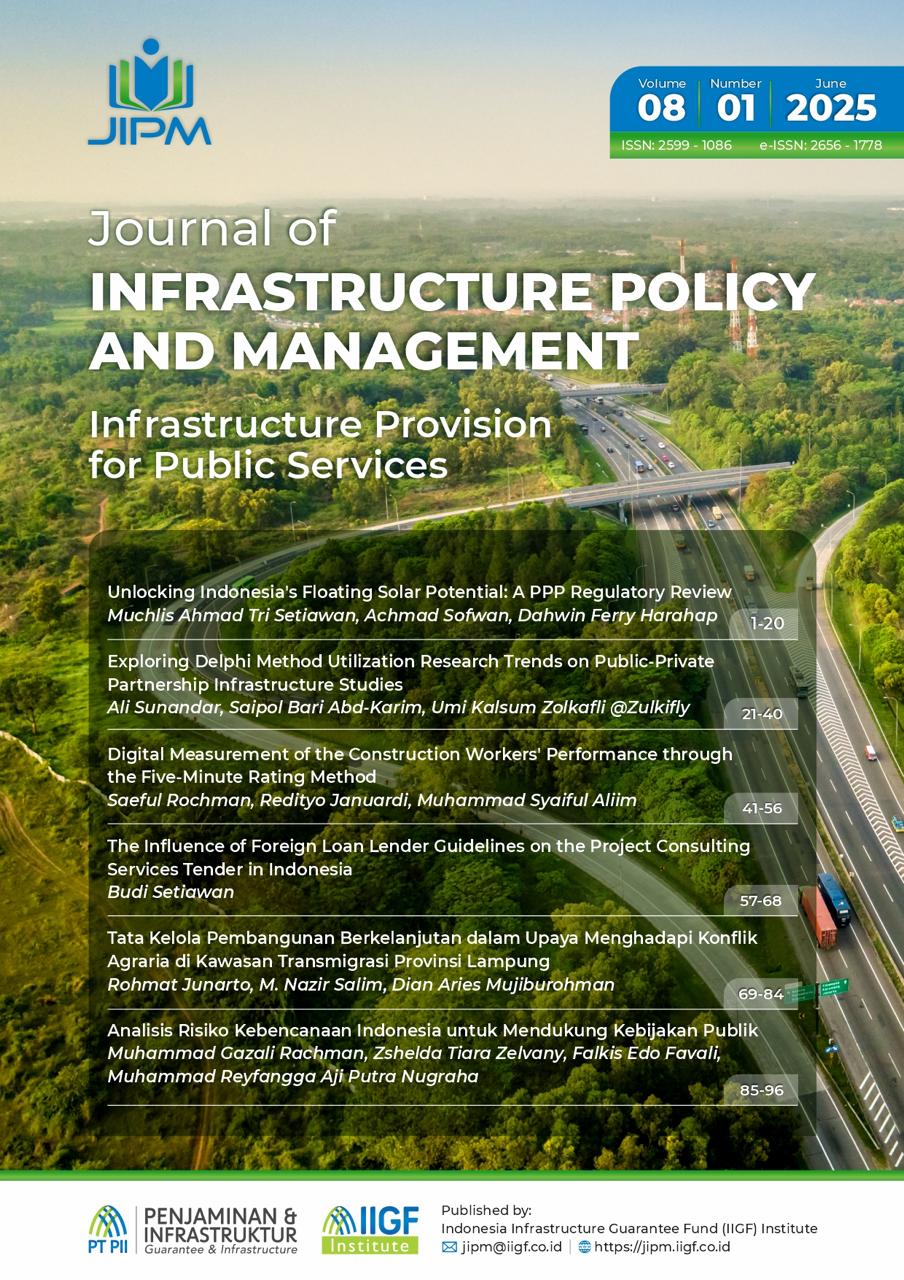Analisis Risiko Kebencanaan Indonesia untuk Mendukung Kebijakan Publik
DOI:
https://doi.org/10.35166/jipm.v8i1.99Keywords:
Earthquake, Fault, Regulation, Risk, TectonicAbstract
Indonesia is situated within an active tectonic zone, rendering it highly susceptible to earthquakes. Earthquake disasters not only result in physical damages and loss of life but also pose significant challenges in formulating adaptive and risk-based public policies. This study aims to analyze earthquake disaster risk in Indonesia and evaluate the extent to which public policy has addressed this potential hazard. The methodology employed is a literature review using a mixed-methods approach: qualitative analysis to examine geological and social aspects, and quantitative analysis through spatial assessments utilizing Geographic Information Systems (GIS). The analysis is grounded in a conceptual disaster risk framework encompassing three main components: hazard, exposure, and capacity. The findings reveal that the presence of active faults traversing densely populated areas, limited public awareness, and weak enforcement of technical regulations such as the Indonesian National Standard (Standar Nasional Indonesia/SNI) for earthquake-resistant buildings contribute to the high disaster risk. This study recommends the integration of disaster education into the school curriculum, the strengthening of technical regulations such as the earthquake-resistant SNI, and the incorporation of local wisdom in building practices as strategies to enhance community resilience to earthquake disasters.
References
Antari, R. D., & Setyaningrum, N. (2023). Pengaruh video edukasi bencana gempa bumi terhadap tingkat pengetahuan kesiapsiagaan bencana gempa bumi pada siswa SDN 1 Pundong Bantul, Yogyakarta. Jurnal Kesehatan Masa Depan (JKMD), 2(2), 138–148. https://jurnal.ruangide.org/JKMD
Arisona, R. D. (2020). Sosialisasi dan simulasi mitigasi bencana gempa bumi dalam meningkatkan kesiapsiagaan siswa SDN 2 Wates Ponorogo. InEJ: Indonesian Engagement Journal, 7, 107–116. http://doi.org/10.21154/inej.v1i1.2049
Badan Standardisasi Nasional. (2019). SNI 1726:2019: Tata cara perencanaan ketahanan gempa untuk struktur bangunan gedung dan nongedung (Keputusan Kepala BSN No. 693/KEP/BSN/12/2019). Badan Standardisasi Nasional.
Hasterok, D., Jacqueline A. H., Alan S. C., Hand, M., Kreemer, C., Gard, M. G., & Glorie, S. (2022). New maps of global geological provinces and tectonic plates. Earth-Science Reviews, 231, https://doi.org/10.1016/j.earscirev.2022.104069.
Farhan, A., Nasution, A. I., & Akhyar. (2024). Earthquake disaster map using GIS analysis: A case study of Bener Meriah-Aceh, Indonesia. Arabian Journal of Geosciences, 17(1), 1–15. https://doi.org/10.1007/s12517-023-11850-y
Hariyanto, A. D., Triyadi, S., & Widyowijatnoko, A. (2023). The adaptability of stilt houses roof structure in earthquake prone region in the context of local seismic culture. Arteks: Jurnal Teknik Arsitektur, 8(1), 1–13. https://doi.org/10.30822/arteks.v8i1.2130
Irsyam, M., Cummins, P., Asrurifak, M., Faizal, L., Natawidjaja, D., Widiyantoro, S., Meilano, I., Triyoso, W., Rudiyanto, A., Hidayati, S., Ridwan, M., Hanifa, N., & Syahbana, A. (2020). Development of the 2017 national seismic hazard maps of Indonesia. Earthquake Spectra, 36(1), 112–136. https://doi.org/10.1177/8755293020951206
Irsyam, M., Hendriyawan, D., Asrurifak, M., Meilano, I., Natawidjaja, D., Widiyantoro, S., Nugraha, A., Sakti, L. M., Sabaruddin, A., Faisal, L., Simatupang, P. T., Hutapea, B., & Afriansyah, T. (2018). Recent efforts to mitigate the impacts of earthquake hazard in Indonesia from a geotechnical engineering perspective. In S. Lai (Ed.), Developments in earthquake geotechnics (pp. 131-150). https://doi.org/10.1007/978-3-319-62069-5_7
Jena, R., Pradhan, B., Beydoun, G., Alamri, A., Ardiansyah, A., Nizamuddin, H., & Sofyan, H. (2020). Integrated model for earthquake risk assessment using neural network and analytic hierarchy process: Aceh province, Indonesia. Geoscience Frontiers. https://doi.org/10.1016/J.GSF.2019.07.006
Kementerian Dalam Negeri Republik Indonesia. (2023). Jumlah penduduk per kabupaten/kota. E-Database. https://e-database.kemendagri.go.id/kemendagri/dataset/257/tabel-data
Kusniyah, A., Sutrisno, S., & Hapsoro, C. A. (2025). Mapping earthquake-prone areas using a probabilistic seismic hazard analysis (PSHA) approach in South Malang Area. IOP Conference Series: Earth and Environmental Science, 1458(1), 012026. https://doi.org/10.1088/1755-1315/1458/1/012026
Lukvianti, F., Mailani, F., & Ananda, Y. (2023). Pengaruh pemberian edukasi kesiapsiagaan bencana gempa bumi pada lansia di Kelurahan Parupuak Tabing Kota Padang. JINTAN: Jurnal Ilmu Keperawatan, 3(2), 93–100. https://doi.org/10.51771/jintan.v3i02.518
Maharani, N. (2024). Analisa pengetahuan dan mitigasi bencana gempa bumi anak-anak di Banjar Mandala Sari Dauh Puri Kelod Bali. Pendipa: Journal of Science Education, 8(1), 78–87. https://doi.org/10.33369/pendipa.8.1.78-87
Makrup, L., Hariyanto, A., & Winarno, S. (2018). Seismic hazard map for Papua Island. International Review of Civil Engineering, 9(2), 57–62. https://doi.org/10.15866/IRECE.V9I2.14090
Muhlisah, N., Arpin, R. M., & Mukarramah, S. K. (2021). Sosialisasi mitigasi bencana alam. Abdimas Toddopuli: Jurnal Pengabdian pada Masyarakat, 2(2), 107–111. https://doi.org/10.30605/atjpm.v2i2.1232
Muslim, D., Zakaria, Z., Sophian, I., Haerani, E., & Yamaoka, S. (2019). Earthquake hazard perception of the education stakeholders in Sukabumi, West Java, Indonesia. Journal of Physics: Conference Series, 1363(1), 012022. https://doi.org/10.1088/1742-6596/1363/1/012022
National Earthquake Study Center Team (PusGEN). (2017). Indonesian earthquake sources and hazards map 2017. Ministry of Public Works and Housing of Indonesia.
NGDC/WDS. (2024). National Centers for Environmental Information. NOAA.
Pratiwi, D. S., Teguh, M., & Pawirodikromo, W. (2019). An implementation of the HAZUS method for estimating potential damage of residential houses at Pacitan Sub-district, East Java, Indonesia due to earthquake. MATEC Web of Conferences, 280, 01008. https://doi.org/10.1051/matecconf/201928001008
Rahayu, T., Mulya, M., Ainun, A., & Sinambela, M. (2020). Seismic micro-zonation framework for earthquake risk in Medan, North Sumatera Indonesia using geotechnical engineering survey. IOP Conference Series: Materials Science and Engineering, 851(1), 012043. https://doi.org/10.1088/1757-899X/851/1/012043
Rais, I. L. N., & Somantri, L. (2021). Analisis bencana gempa bumi dan mitigasi bencana di daerah Kertasari. Jurnal Samudra Geografi, 4(2), 14–19. https://doi.org/10.33059/jsg.v4i2.3773
Sengara, I., & Aldiamar, F. (2021). Assessment on earthquake resistance spectral design load criteria for buildings and infrastructures in Indonesia. E3S Web of Conferences, 133, 07009. https://doi.org/10.1051/e3sconf/202133107009
Supendi, P., Nugraha, A. D., Widiyantoro, S., Pesicek, J. D., Thurber, C. H, Abdullah, C. I., Daryono, D., Wiyono, S. H., Shiddiqi, H. A., & Rosalia, H., (2020). Relocated aftershocks and background seismicity in eastern Indonesia shed light on the 2018 Lombok and Palu earthquake sequences, Geophysical International Journal, 221(3), 1845–1855, https://doi.org/10.1093/gji/ggaa118
Watkinson, I., & Hall, R. (2017). Fault systems of the eastern Indonesian triple junction: Evaluation of quaternary activity and implications for seismic hazards. Geological Society: Special Publications, 441, 120-171. https://doi.org/10.1144/SP441.8
Downloads
Published
Issue
Section
License
Copyright (c) 2025 Journal of Infrastructure Policy and Management (JIPM)

This work is licensed under a Creative Commons Attribution-ShareAlike 4.0 International License.















